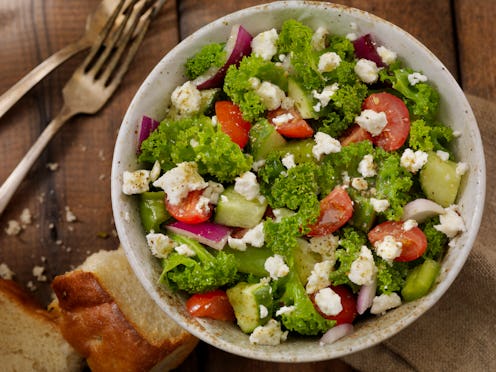Life
6 Ways You Can Tell If Your Food Is Healthy

When it comes to eating well, sometimes the biggest struggle is being able to figure out if something is good for you or not. With so many different products all making different health claims on their labels, it's essential you have the tools to be able to tell if a food is actually healthy. There's a lot to know about healthy eating, so the more you educate yourself, the better, but not everyone has all day to read up on the latest study or to debunk a widely circulated myth.
"There's so much information and misinformation, it's hard to know what's right and based on scientific evidence or what's wrong or based on minimal evidence of anecdote," says Elisa Zied, RD, author of Younger Next Week over email. "Also, the mere act of reading food labels can be daunting with so much info packed onto a small package."
Although there is no one-size-fits-all solution to determining whether or not something is healthy, there are some key factors you can pay attention to that will help you figure out how nutritious a food really is. Next time you're grocery shopping or out to eat, consider using these six tips to help you tell if what you're eating is actually healthy.
1. Check The Ingredient List
"Always read the ingredient list," says My Fit Foods nutritionist Jenny Smith over email. "The best foods should read like a recipe you can recreate at home. Think to yourself, can I buy the majority of these ingredients at my local grocery store?" Ingredients are listed in order of most used first, so make sure the healthiest ingredients are highest up on the list.
2. Look At Serving Size
"This number is often located at the top of every food label," says Smith. "However, this number is a measurement, not a recommendation, and indicates the amount of food for which the nutritional information is based on." If all the nutritional numbers seem to good to be true, you're probably dealing with a small serving, which may not be the best option to fill you up and keep you nourished.
3. It's Low In Sodium
"It is not healthy to purchase processed foods with added sodium," says Smith. "This can increase your blood pressure, risk of diabetes, or risk of chronic kidney disease. The Dietary Guidelines for Americans recommend limiting sodium to less than 2,300 mg a day or 1,500 mg if your 51 or older, so check out the label and make sure you're within this limit."
4. It Contains Natural Sugars
"Less [sugar] is better," says Smith. "Most nutrition labels do not distinguish between natural and added sugars, so be sure to keep a close eye on processed forms of sugar hidden in the label ingredients." Look for foods sweetened with fruit, honey, or dates, and avoid cane sugar, corn syrup, and anything ending in "ose."
5. Pay Attention To Fats
Avoid foods that contain trans fat or saturated fat, and opt for the monounsaturated kind instead, found in nuts, olive oil, and avocados. However, be cautious of foods that say low-fat or fat-free. "Many fat-free and low-fat foods have added sugar," says Smith.
6. Be Wary Of Buzz Words
"Nutrition labels and product packaging can use misleading phrases such as 'all-natural' or 'fat-free,' enticing the consumer to purchase a product when in reality, the product is not healthy at all," says Smith. "Many companies hype up certain 'healthy' words that are gaining a lot of attention." There are no regulations for these words, so check the ingredients before grabbing it off the shelf.
In general, opting for whole, unprocessed foods will ensure that you're eating is the healthiest.
Images: Getty Images (7)